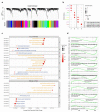New insights into aging-associated characteristics of female subcutaneous adipose tissue through integrative analysis of multi-omics data
- PMID: 35001792
- PMCID: PMC8973830
- DOI: 10.1080/21655979.2021.2020467
New insights into aging-associated characteristics of female subcutaneous adipose tissue through integrative analysis of multi-omics data
Abstract
Aging could be critical in limiting the application of subcutaneous adipose tissue (SAT) in tissue repair and reconstruction. However, no systematic study on the characteristics of SAT aging has been conducted. In this study, a scanning electronic microscope was used to detect the structural and compositional changes of SAT collected from nine females in three age groups. Multi-omics data of SAT from 37 females were obtained from Gene Expression Omnibus database, and 1860 genes, 56 miRNAs, and 332 methylated genes were identified as being differentially expressed during aging among non-obese females. Using Weighted Correlation Network Analysis (WGCNA), 1754 DEGs were defined as aging-associated genes for non-obese females, distributed among ten co-expression modules. Through Gene Ontology enrichment analysis and Gene Set enrichment analysis on those aging-associated DEGs, SAT aging was observed to be characterized by variations in immune and inflammatory states, mitochondria, lipid and carbohydrate metabolism, and regulation of vascular development. SUPV3L1, OGT, and ARPC1B were identified as conserved and core SAT-aging-related genes, as verified by RT-qPCR among 18 samples in different age groups. Multi-omics regulatory networks of core aging-associated biological processes of SAT were also constructed. Based on WGCNA, we performed differential co-expression analysis to unveil the differences in aging-related co-expression patterns between obese and non-obese females and determined that obesity could be an important accelerating factor in aging processes. Our work provides a landscape of SAT aging, which could be helpful for further research in fields such as repair and reconstruction as well as aging.
Keywords: Subcutaneous adipose tissue; aging; multi-omics profiling; obesity; tissue repair and reconstruction.
Conflict of interest statement
No potential conflict of interest was reported by the author(s).
Figures





Similar articles
-
Co-expressed immune and metabolic genes in visceral and subcutaneous adipose tissue from severely obese individuals are associated with plasma HDL and glucose levels: a microarray study.BMC Med Genomics. 2010 Aug 5;3:34. doi: 10.1186/1755-8794-3-34. BMC Med Genomics. 2010. PMID: 20687939 Free PMC article.
-
Screening of exosomal miRNAs derived from subcutaneous and visceral adipose tissues: Determination of targets for the treatment of obesity and associated metabolic disorders.Mol Med Rep. 2018 Sep;18(3):3314-3324. doi: 10.3892/mmr.2018.9312. Epub 2018 Jul 24. Mol Med Rep. 2018. PMID: 30066923 Free PMC article.
-
Multi-omics Integrative Investigation of Fatty Acid Metabolism in Obese and Lean Subcutaneous Tissue.OMICS. 2017 Jul;21(7):371-379. doi: 10.1089/omi.2017.0049. Epub 2017 Jun 15. OMICS. 2017. PMID: 28618245
-
Two Faces of White Adipose Tissue with Heterogeneous Adipogenic Progenitors.Diabetes Metab J. 2019 Dec;43(6):752-762. doi: 10.4093/dmj.2019.0174. Diabetes Metab J. 2019. PMID: 31902145 Free PMC article. Review.
-
Landscape of sex differences in obesity and type 2 diabetes in subcutaneous adipose tissue: a systematic review and meta-analysis of transcriptomics studies.Metabolism. 2025 Jul;168:156241. doi: 10.1016/j.metabol.2025.156241. Epub 2025 Mar 27. Metabolism. 2025. PMID: 40157598
Cited by
-
Applying causal discovery to single-cell analyses using CausalCell.Elife. 2023 May 2;12:e81464. doi: 10.7554/eLife.81464. Elife. 2023. PMID: 37129360 Free PMC article.
-
Aging and obesity prime the methylome and transcriptome of adipose stem cells for disease and dysfunction.FASEB J. 2023 Mar;37(3):e22785. doi: 10.1096/fj.202201413R. FASEB J. 2023. PMID: 36794668 Free PMC article.
-
Does diet influence aging? Evidence from animal studies.J Intern Med. 2024 Apr;295(4):400-415. doi: 10.1111/joim.13530. Epub 2022 Jun 24. J Intern Med. 2024. PMID: 35701180 Free PMC article. Review.
-
Sex- and age-specific associations between abdominal fat and non-alcoholic fatty liver disease: a prospective cohort study.J Mol Cell Biol. 2024 Apr 10;15(11):mjad069. doi: 10.1093/jmcb/mjad069. J Mol Cell Biol. 2024. PMID: 38037475 Free PMC article.
-
Emerging technologies in adipose tissue research.Adipocyte. 2023 Dec;12(1):2248673. doi: 10.1080/21623945.2023.2248673. Adipocyte. 2023. PMID: 37599422 Free PMC article. Review.
References
-
- Cai L, Han XF, Wang BQ, et al. [Application of autologous fat grafting in breast reconstruction]. Zhonghua Wai Ke Za Zhi. 2017;55(9):696–701. - PubMed
-
- Fang L, Chen JJ, Cen Y.. [Advances in the research of autologous fat grafting in the prevention and treatment of scar]. Zhonghua Shao Shang Za Zhi. 2019;35(3):233–236. - PubMed
-
- Russe E, Kholosy H, Weitgasser L, et al. Autologous fat grafting for enhancement of breast reconstruction with a transverse myocutaneous gracilis flap: a cohort study. J Plast Reconstr Aesthet Surg. 2018;71(11):1557–1562. - PubMed
Publication types
MeSH terms
LinkOut - more resources
Full Text Sources
Other Literature Sources
Medical
Research Materials
Miscellaneous
